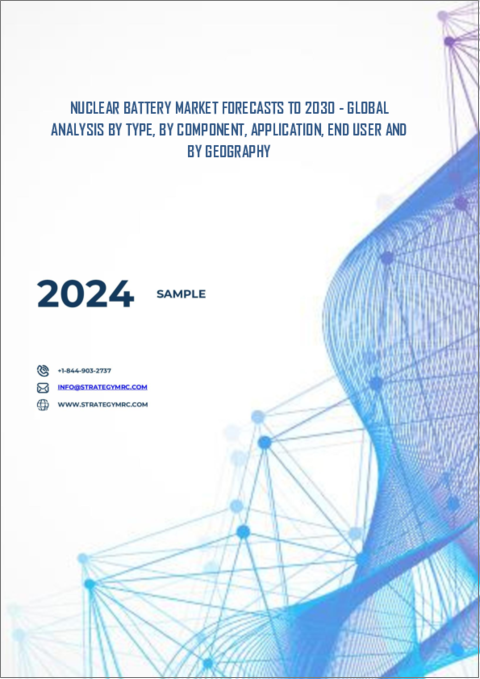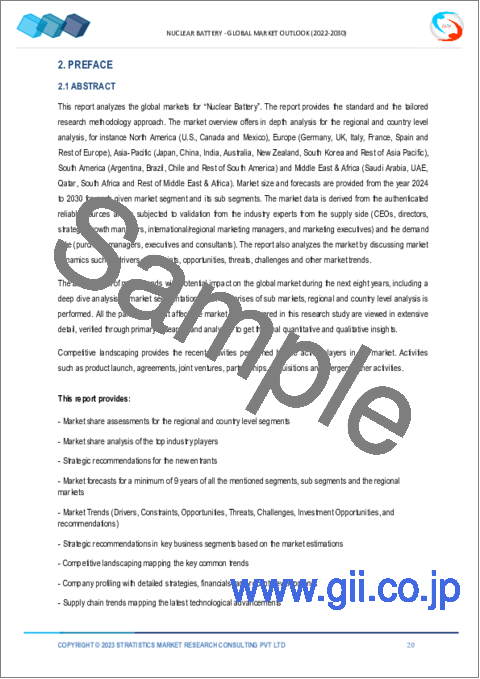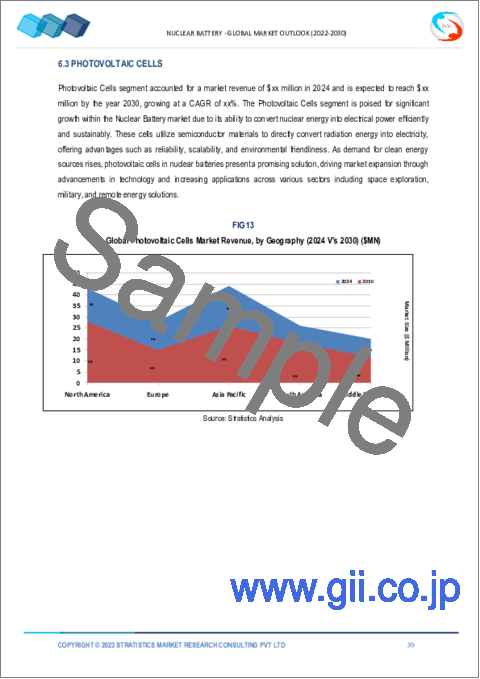|
|
市場調査レポート
商品コード
1447140
原子力電池市場の2030年までの予測: タイプ別、コンポーネント別、用途別、エンドユーザー別、地域別の世界分析Nuclear Battery Market Forecasts to 2030 - Global Analysis By Type, By Component, Application, End User and By Geography |
||||||
カスタマイズ可能
|
|||||||
| 原子力電池市場の2030年までの予測: タイプ別、コンポーネント別、用途別、エンドユーザー別、地域別の世界分析 |
|
出版日: 2024年03月03日
発行: Stratistics Market Research Consulting
ページ情報: 英文 200+ Pages
納期: 2~3営業日
|
- 全表示
- 概要
- 図表
- 目次
Stratistics MRCによると、世界の原子力電池市場は2023年に760億3,000万米ドルを占め、2030年には1,435億2,000万米ドルに達すると予測され、予測期間中のCAGRは9.5%です。
原子力電池は、放射性同位元素の制御された崩壊によって発電する、コンパクトで長持ちする電源です。核反応から放出されるエネルギーを利用して安定した電力供給を生み出し、さまざまな用途に信頼性が高く効率的な電源を提供します。
長寿命で信頼性の高い電源への需要の高まり
産業やアプリケーションが継続的で中断のない電力供給を必要とする中、原子力電池はその長寿命と信頼性により説得力のあるソリューションを提供します。従来の電池とは異なり、原子力電池は頻繁な交換や再充電の必要なく長期間電力を供給できるため、遠隔センサー、宇宙船、医療用インプラントなど、メンテナンスやアクセスが困難な用途に最適です。この需要が原子力電池市場の成長を後押ししています。
高コストと複雑な製造
原子力電池の開発・製造には特殊な施設、設備、専門知識が必要であり、多額の先行投資が発生します。さらに、厳格な安全規制とプロトコルが製造の複雑さと費用を増大させる。こうした要因が原子力電池の全体的なコスト高を招き、その普及と商業的実行可能性を制限しています。
放射性同位元素材料と技術の進歩
現在進行中の研究開発は、原子力電池の構造に使用される放射性同位元素材料の特性を改善することにより、原子力電池の効率、安全性、および寿命を向上させることを目的としています。これらの進歩により、よりコンパクトで、費用対効果が高く、環境に優しい原子力電池ソリューションの開発が可能になります。さらに、放射性同位体の封入および遮蔽技術の革新は、商業的な実現可能性と様々な産業における原子力電池の広範な採用に寄与しています。
代替技術との競合
再生可能エネルギー源とエネルギー貯蔵ソリューションの進歩が実行可能な代替技術を提供するため、代替技術との競合が原子力電池市場に脅威を与えています。太陽電池、風力発電、リチウムイオン電池は、持続可能でコスト効率の高い選択肢を提供し、原子力発電への依存度を低下させる。さらに、核廃棄物処理と安全性に関する懸念が、市場拡大を妨げるさらなる課題となっています。
COVID-19の影響:
COVID-19パンデミックは、サプライチェーンを混乱させ、製造活動を遅延させ、非必須用途の需要を減少させることにより、原子力電池市場に影響を及ぼしています。渡航制限や封鎖措置は、プロジェクトの設置や保守活動に支障をきたし、プロジェクトの遅延や中止につながった。しかし、パンデミックは信頼できる電源の重要性も浮き彫りにしており、医療機器や遠隔センサーなどの重要用途向けの原子力電池への関心を高める可能性があります。
予測期間中、放射性元素セグメントが最大になる見込み
放射性元素セグメントは、一次エネルギー源として不可欠な役割を果たすため、予測期間中、原子力電池市場をリードする見通しです。プルトニウム238、トリチウム、アメリシウム241のような同位体は、崩壊によって放射線を放出し、様々なタイプの原子力電池で発電の基礎となります。宇宙開発、医療用インプラント、軍事機器などの用途で信頼性が高く長持ちする電力ソリューションへの需要が高まる中、放射性元素セグメントは優位性を維持し、市場成長を大きく牽引すると予想されます。
宇宙機関および航空宇宙企業セグメントは予測期間中に最も高いCAGRが見込まれる
宇宙機関および航空宇宙企業セグメントは、予測期間中、原子力電池市場で最も高い成長率が見込まれています。この成長は、宇宙探査ミッション、衛星配備、深宇宙探査の増加に起因しており、原子力電池は、過酷な遠隔環境で信頼性が高く長持ちする電源を提供するために不可欠です。さらに、宇宙技術の進歩と自律的で持続可能なエネルギー・ソリューションに対する需要の高まりが、航空宇宙産業における原子力電池の採用をさらに後押ししています。
最大のシェアを持つ地域:
北米地域は、研究開発への多額の投資、主要な市場プレイヤーの強力なプレゼンス、原子力電池技術の採用を促進する政府の支援イニシアティブにより、最大の市場シェアを獲得する見込みです。さらに、同地域の高度なインフラストラクチャー、強固な技術力、防衛・航空宇宙・産業分野における信頼性の高い電源に対する需要の増加が、原子力電池市場における北米の優位性に寄与しています。
CAGRが最も高い地域:
欧州は、政府の支援政策、原子力研究への投資、再生可能エネルギー統合への注目の高まりにより、原子力電池市場の急成長に位置づけられています。この地域は脱炭素化とエネルギー安全保障を重視しており、増大するエネルギー需要を満たすために原子力電池を含む代替電源の採用を推進しています。さらに、業界関係者と研究機関の協力が技術革新と技術開発を促進し、欧州の原子力電池市場の成長をさらに後押ししています。
無料のカスタマイズサービス
本レポートをご購読のお客様には、以下の無料カスタマイズオプションのいずれかをご利用いただけます:
- 企業プロファイル
- 追加市場プレイヤーの包括的プロファイリング(3社まで)
- 主要企業のSWOT分析(3社まで)
- 地域セグメンテーション
- 顧客の関心に応じた主要国の市場推計・予測・CAGR(注:フィージビリティチェックによる)
- 競合ベンチマーキング
- 製品ポートフォリオ、地理的プレゼンス、戦略的提携に基づく主要企業のベンチマーキング
目次
第1章 エグゼクティブサマリー
第2章 序文
- 概要
- ステークホルダー
- 調査範囲
- 調査手法
- データマイニング
- データ分析
- データ検証
- 調査アプローチ
- 調査ソース
- 1次調査ソース
- 2次調査ソース
- 前提条件
第3章 市場動向分析
- 促進要因
- 抑制要因
- 機会
- 脅威
- 用途分析
- エンドユーザー分析
- 新型コロナウイルス感染症(COVID-19)の影響
第4章 ポーターのファイブフォース分析
- 供給企業の交渉力
- 買い手の交渉力
- 代替品の脅威
- 新規参入業者の脅威
- 競争企業間の敵対関係
第5章 世界の原子力電池市場:タイプ別
- 熱変換電池
- 非熱変換電池
- ダイヤモンド核電池
第6章 世界の原子力電池市場:コンポーネント別
- 封止材
- 太陽電池
- 放射性元素
- 半導体材料
- 熱電材料
- その他のコンポーネント
第7章 世界の原子力電池市場:用途別
- 宇宙探査
- 産業用センサーおよび計測器
- 軍事と防衛
- 遠隔監視システム
- その他の用途
第8章 世界の原子力電池市場:エンドユーザー別
- 宇宙機関と航空宇宙企業
- エネルギー会社
- 環境監視機関
- 産業施設
- 医療機器メーカー
- その他のエンドユーザー
第9章 世界の原子力電池市場:地域別
- 北米
- 米国
- カナダ
- メキシコ
- 欧州
- ドイツ
- 英国
- イタリア
- フランス
- スペイン
- その他欧州
- アジア太平洋地域
- 日本
- 中国
- インド
- オーストラリア
- ニュージーランド
- 韓国
- その他アジア太平洋地域
- 南米
- アルゼンチン
- ブラジル
- チリ
- その他南米
- 中東とアフリカ
- サウジアラビア
- アラブ首長国連邦
- カタール
- 南アフリカ
- その他中東とアフリカ
第10章 主な発展
- 契約、パートナーシップ、コラボレーション、合弁事業
- 買収と合併
- 新製品の発売
- 事業拡大
- その他の主要戦略
第11章 企業プロファイル
- Advanced American Battery Technology
- AMETEK, Inc.
- Atomica Energy, Inc.
- Citylabs Co., Ltd.
- Curtiss-Wright Corporation
- EaglePicher Technologies, LLC
- Exide Technologies
- II-VI Incorporated
- Qynergy Corporation
- Tesla Inc.
- Toshiba Corporation
- Ultralife Corporation
- Beijing Betavolt New Energy Technology Co., Ltd.
List of Tables
- Table 1 Global Nuclear Battery Market Outlook, By Region (2021-2030) ($MN)
- Table 2 Global Nuclear Battery Market Outlook, By Type (2021-2030) ($MN)
- Table 3 Global Nuclear Battery Market Outlook, By Thermal Conversion Batteries (2021-2030) ($MN)
- Table 4 Global Nuclear Battery Market Outlook, By Non-Thermal Conversion Batteries (2021-2030) ($MN)
- Table 5 Global Nuclear Battery Market Outlook, By Nuclear Diamond Batteries (2021-2030) ($MN)
- Table 6 Global Nuclear Battery Market Outlook, By Component (2021-2030) ($MN)
- Table 7 Global Nuclear Battery Market Outlook, By Encapsulation Materials (2021-2030) ($MN)
- Table 8 Global Nuclear Battery Market Outlook, By Photovoltaic Cells (2021-2030) ($MN)
- Table 9 Global Nuclear Battery Market Outlook, By Radioactive Elements (2021-2030) ($MN)
- Table 10 Global Nuclear Battery Market Outlook, By Semiconductor Materials (2021-2030) ($MN)
- Table 11 Global Nuclear Battery Market Outlook, By Thermoelectric Materials (2021-2030) ($MN)
- Table 12 Global Nuclear Battery Market Outlook, By Other Components (2021-2030) ($MN)
- Table 13 Global Nuclear Battery Market Outlook, By Application (2021-2030) ($MN)
- Table 14 Global Nuclear Battery Market Outlook, By Space Exploration (2021-2030) ($MN)
- Table 15 Global Nuclear Battery Market Outlook, By Industrial Sensors and Instruments (2021-2030) ($MN)
- Table 16 Global Nuclear Battery Market Outlook, By Military and Defense (2021-2030) ($MN)
- Table 17 Global Nuclear Battery Market Outlook, By Remote Monitoring Systems (2021-2030) ($MN)
- Table 18 Global Nuclear Battery Market Outlook, By Other Applications (2021-2030) ($MN)
- Table 19 Global Nuclear Battery Market Outlook, By End User (2021-2030) ($MN)
- Table 20 Global Nuclear Battery Market Outlook, By Space Agencies and Aerospace Companies (2021-2030) ($MN)
- Table 21 Global Nuclear Battery Market Outlook, By Energy Companies (2021-2030) ($MN)
- Table 22 Global Nuclear Battery Market Outlook, By Environmental Monitoring Agencies (2021-2030) ($MN)
- Table 23 Global Nuclear Battery Market Outlook, By Industrial Facilities (2021-2030) ($MN)
- Table 24 Global Nuclear Battery Market Outlook, By Medical Device Manufacturers (2021-2030) ($MN)
- Table 25 Global Nuclear Battery Market Outlook, By Other End Users (2021-2030) ($MN)
Note: Tables for North America, Europe, APAC, South America, and Middle East & Africa Regions are also represented in the same manner as above.
According to Stratistics MRC, the Global Nuclear Battery Market is accounted for $76.03 billion in 2023 and is expected to reach $143.52 billion by 2030 growing at a CAGR of 9.5% during the forecast period. A nuclear battery is a compact, long-lasting power source that generates electricity through the controlled decay of radioactive isotopes. It utilizes the energy released from nuclear reactions to produce a steady supply of electricity, providing a reliable and efficient power source for various applications.
Market Dynamics:
Driver:
Increasing demand for long-lasting, reliable power sources
As industries and applications require continuous and uninterrupted power supply, nuclear batteries offer a compelling solution due to their longevity and reliability. Unlike traditional batteries, nuclear batteries can provide power for extended periods without the need for frequent replacement or recharging, making them ideal for applications such as remote sensors, spacecraft, and medical implants where maintenance and accessibility are challenging. This demand fuels the growth of the nuclear battery market.
Restraint:
High cost and complex manufacturing
Developing and producing nuclear batteries requires specialized facilities, equipment, and expertise, which incur substantial upfront investments. Additionally, stringent safety regulations and protocols add to the complexity and expense of manufacturing. These factors contribute to the overall high cost of nuclear batteries, limiting their widespread adoption and commercial viability.
Opportunity:
Advancements in radioisotope materials and technologies
Ongoing research and development efforts aim to enhance the efficiency, safety, and lifespan of nuclear batteries by improving the properties of radioisotope materials used in their construction. These advancements enable the development of more compact, cost-effective, and environmentally friendly nuclear battery solutions. Additionally, innovations in radioisotope encapsulation and shielding technologies contribute to the commercial viability and widespread adoption of nuclear batteries across various industries.
Threat:
Competition from alternative technologies
Competition from alternative technologies presents a threat to the nuclear battery market as advancements in renewable energy sources and energy storage solutions offer viable alternatives. Solar, wind, and lithium-ion batteries provide sustainable and cost-effective options, reducing dependence on nuclear power. Moreover, concerns regarding nuclear waste disposal and safety issues pose additional challenges that hinder market expansion.
Covid-19 Impact:
The COVID-19 pandemic has impacted the nuclear battery market by disrupting supply chains, delaying manufacturing activities, and reducing demand for non-essential applications. Travel restrictions and lockdown measures have hindered project installations and maintenance activities, leading to project delays and cancellations. However, the pandemic has also highlighted the importance of reliable power sources, potentially driving interest in nuclear batteries for critical applications such as medical devices and remote sensors.
The radioactive elements segment is expected to be the largest during the forecast period
The radioactive elements segment is poised to lead the nuclear batteries market during the forecast period due to their indispensable role as primary energy sources. Isotopes like plutonium-238, tritium, and americium-241 emit radiation through decay, serving as the foundation for power generation in various nuclear battery types. With increasing demand for reliable and long-lasting power solutions in applications such as space exploration, medical implants, and military devices, the radioactive elements segment is expected to maintain dominance, driving market growth significantly.
The space agencies and aerospace companies segment is expected to have the highest CAGR during the forecast period
The space agencies and aerospace companies segment is anticipated to experience the highest growth rate in the nuclear batteries market during the forecast period. This growth is attributed to increased space exploration missions, satellite deployments, and deep space probes, where nuclear batteries are essential for providing reliable and long-lasting power sources in harsh and remote environments. Additionally, advancements in space technologies and the growing demand for autonomous and sustainable energy solutions further drive the adoption of nuclear batteries in the aerospace industry.
Region with largest share:
The North American region is poised to capture the largest market share owing to significant investments in research and development, a strong presence of key market players, and supportive government initiatives promoting the adoption of nuclear battery technology. Additionally, the region's advanced infrastructure, robust technological capabilities, and increasing demand for reliable power sources in defense, aerospace, and industrial sectors contribute to the anticipated dominance of North America in the nuclear battery market.
Region with highest CAGR:
Europe is positioned for rapid growth in the nuclear battery market due to supportive government policies, investments in nuclear research, and an increasing focus on renewable energy integration. The region's emphasis on decarbonization and energy security drives the adoption of alternative power sources, including nuclear batteries, to meet growing energy demands. Additionally, collaborations between industry players and research institutions foster innovation and technology development, further propelling the growth of the nuclear battery market in Europe.
Key players in the market
Some of the key players in Nuclear Battery Market include Advanced American Battery Technology, AMETEK, Inc., Atomica Energy, Inc., Citylabs Co., Ltd., Curtiss-Wright Corporation, EaglePicher Technologies, LLC, Exide Technologies, II-VI Incorporated, Qynergy Corporation, Tesla Inc., Toshiba Corporation, Ultralife Corporation and Beijing Betavolt New Energy Technology Co., Ltd.
Key Developments:
In January 2024, Beijing Betavolt New Energy Technology Co., Ltd. announced that it has successfully developed a miniature atomic energy battery. This product combines nickel -63 nuclear isotope decay technology and China's first diamond semiconductor (4th generation semiconductor) module to successfully realize the miniaturization of atomic energy batteries. , modularization and low cost, starting the process of civilian use.
In December 2023, Exide Technologies, a global leader in stored energy solutions, continues to follow the road towards customer excellence. We are pleased to announce the recent strategic agreement with Juice Stored Energy Limited for the transfer of its Service Department in the Netherlands and Belgium. This agreement encompasses all current service employees, who will be pivotal to the success of this transition. It marks a significant decision by Exide to ensure the long-term sustainability and efficiency of service operations and customer support in the region.
Types Covered:
- Thermal Conversion Batteries
- Non-Thermal Conversion Batteries
- Nuclear Diamond Batteries
Components Covered:
- Encapsulation Materials
- Photovoltaic Cells
- Radioactive Elements
- Semiconductor Materials
- Thermoelectric Materials
- Other Components
Applications Covered:
- Space Exploration
- Industrial Sensors and Instruments
- Military and Defense
- Remote Monitoring Systems
- Other Applications
End Users Covered:
- Space Agencies and Aerospace Companies
- Energy Companies
- Environmental Monitoring Agencies
- Industrial Facilities
- Medical Device Manufacturers
- Other End Users
Regions Covered:
- North America
- US
- Canada
- Mexico
- Europe
- Germany
- UK
- Italy
- France
- Spain
- Rest of Europe
- Asia Pacific
- Japan
- China
- India
- Australia
- New Zealand
- South Korea
- Rest of Asia Pacific
- South America
- Argentina
- Brazil
- Chile
- Rest of South America
- Middle East & Africa
- Saudi Arabia
- UAE
- Qatar
- South Africa
- Rest of Middle East & Africa
What our report offers:
- Market share assessments for the regional and country-level segments
- Strategic recommendations for the new entrants
- Covers Market data for the years 2021, 2022, 2023, 2026, and 2030
- Market Trends (Drivers, Constraints, Opportunities, Threats, Challenges, Investment Opportunities, and recommendations)
- Strategic recommendations in key business segments based on the market estimations
- Competitive landscaping mapping the key common trends
- Company profiling with detailed strategies, financials, and recent developments
- Supply chain trends mapping the latest technological advancements
Free Customization Offerings:
All the customers of this report will be entitled to receive one of the following free customization options:
- Company Profiling
- Comprehensive profiling of additional market players (up to 3)
- SWOT Analysis of key players (up to 3)
- Regional Segmentation
- Market estimations, Forecasts and CAGR of any prominent country as per the client's interest (Note: Depends on feasibility check)
- Competitive Benchmarking
- Benchmarking of key players based on product portfolio, geographical presence, and strategic alliances
Table of Contents
1 Executive Summary
2 Preface
- 2.1 Abstract
- 2.2 Stake Holders
- 2.3 Research Scope
- 2.4 Research Methodology
- 2.4.1 Data Mining
- 2.4.2 Data Analysis
- 2.4.3 Data Validation
- 2.4.4 Research Approach
- 2.5 Research Sources
- 2.5.1 Primary Research Sources
- 2.5.2 Secondary Research Sources
- 2.5.3 Assumptions
3 Market Trend Analysis
- 3.1 Introduction
- 3.2 Drivers
- 3.3 Restraints
- 3.4 Opportunities
- 3.5 Threats
- 3.6 Application Analysis
- 3.7 End User Analysis
- 3.8 Impact of Covid-19
4 Porters Five Force Analysis
- 4.1 Bargaining power of suppliers
- 4.2 Bargaining power of buyers
- 4.3 Threat of substitutes
- 4.4 Threat of new entrants
- 4.5 Competitive rivalry
5 Global Nuclear Battery Market, By Type
- 5.1 Introduction
- 5.2 Thermal Conversion Batteries
- 5.3 Non-Thermal Conversion Batteries
- 5.4 Nuclear Diamond Batteries
6 Global Nuclear Battery Market, By Component
- 6.1 Introduction
- 6.2 Encapsulation Materials
- 6.3 Photovoltaic Cells
- 6.4 Radioactive Elements
- 6.5 Semiconductor Materials
- 6.6 Thermoelectric Materials
- 6.7 Other Components
7 Global Nuclear Battery Market, By Application
- 7.1 Introduction
- 7.2 Space Exploration
- 7.3 Industrial Sensors and Instruments
- 7.4 Military and Defense
- 7.5 Remote Monitoring Systems
- 7.6 Other Applications
8 Global Nuclear Battery Market, By End User
- 8.1 Introduction
- 8.2 Space Agencies and Aerospace Companies
- 8.3 Energy Companies
- 8.4 Environmental Monitoring Agencies
- 8.5 Industrial Facilities
- 8.6 Medical Device Manufacturers
- 8.7 Other End Users
9 Global Nuclear Battery Market, By Geography
- 9.1 Introduction
- 9.2 North America
- 9.2.1 US
- 9.2.2 Canada
- 9.2.3 Mexico
- 9.3 Europe
- 9.3.1 Germany
- 9.3.2 UK
- 9.3.3 Italy
- 9.3.4 France
- 9.3.5 Spain
- 9.3.6 Rest of Europe
- 9.4 Asia Pacific
- 9.4.1 Japan
- 9.4.2 China
- 9.4.3 India
- 9.4.4 Australia
- 9.4.5 New Zealand
- 9.4.6 South Korea
- 9.4.7 Rest of Asia Pacific
- 9.5 South America
- 9.5.1 Argentina
- 9.5.2 Brazil
- 9.5.3 Chile
- 9.5.4 Rest of South America
- 9.6 Middle East & Africa
- 9.6.1 Saudi Arabia
- 9.6.2 UAE
- 9.6.3 Qatar
- 9.6.4 South Africa
- 9.6.5 Rest of Middle East & Africa
10 Key Developments
- 10.1 Agreements, Partnerships, Collaborations and Joint Ventures
- 10.2 Acquisitions & Mergers
- 10.3 New Product Launch
- 10.4 Expansions
- 10.5 Other Key Strategies
11 Company Profiling
- 11.1 Advanced American Battery Technology
- 11.2 AMETEK, Inc.
- 11.3 Atomica Energy, Inc.
- 11.4 Citylabs Co., Ltd.
- 11.5 Curtiss-Wright Corporation
- 11.6 EaglePicher Technologies, LLC
- 11.7 Exide Technologies
- 11.8 II-VI Incorporated
- 11.9 Qynergy Corporation
- 11.10 Tesla Inc.
- 11.11 Toshiba Corporation
- 11.12 Ultralife Corporation
- 11.13 Beijing Betavolt New Energy Technology Co., Ltd.






